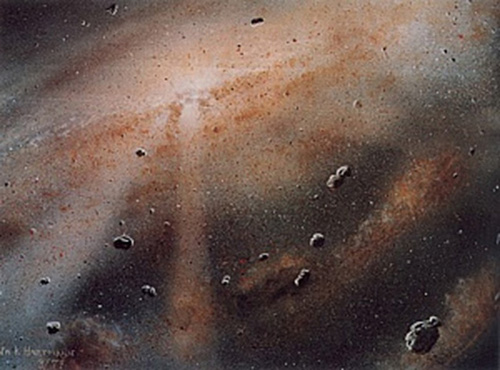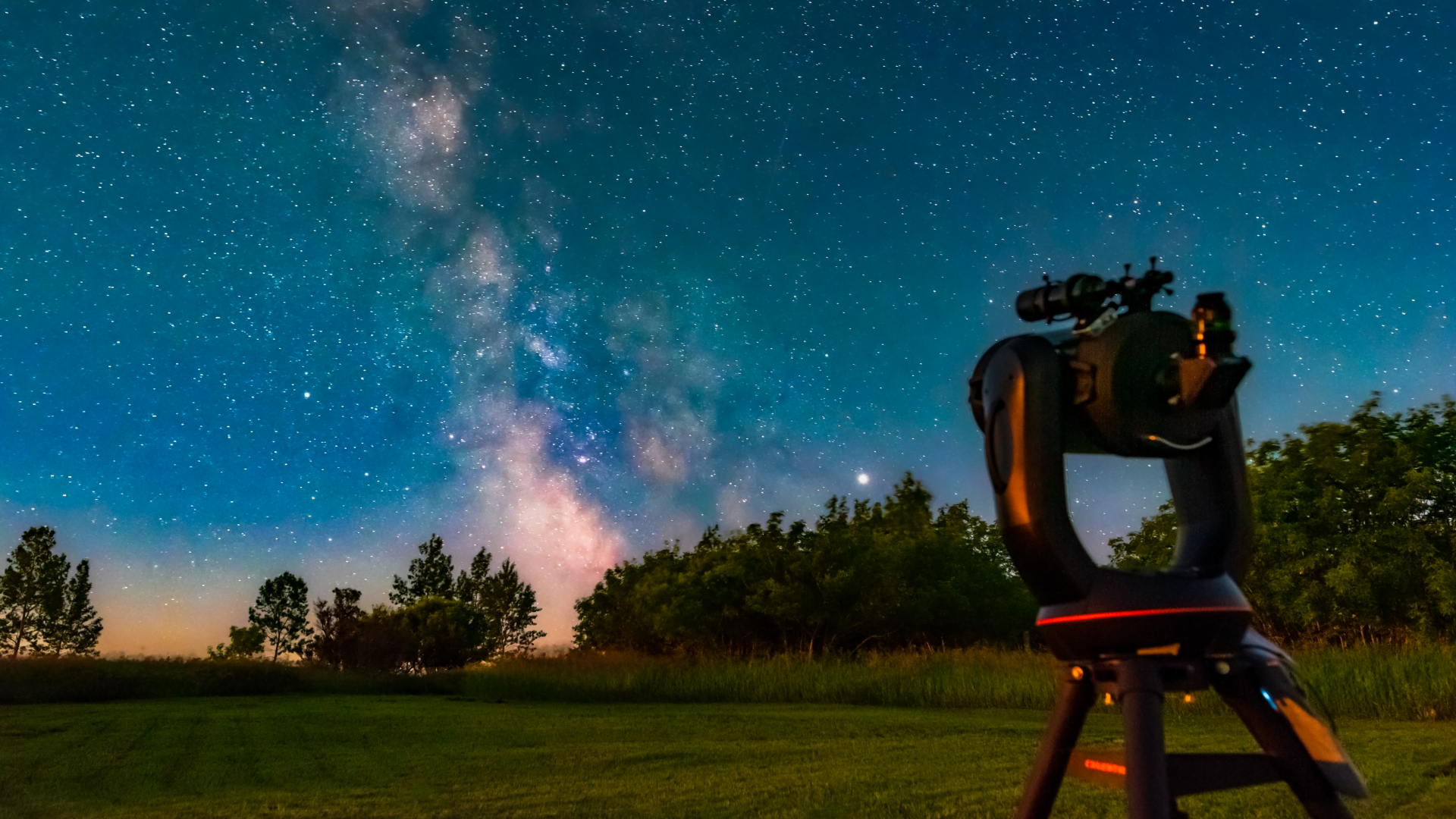How Was Jupiter Formed?
Although planets surround stars in the galaxy, how they form remains a subject of debate. Despite the wealth of worlds in our own solar system, scientists still aren't certain how planets are built. Currently, two theories are duking it out for the role of champion.
While the first, core accretion, works well with the formation of terrestrial planes, scientists have difficulty reconciling it with giant planets like Jupiter. A more recent model known as disk instability may help solve some of the problems that core accretion fails to address in scientists' views of how the solar system formed.
Weighing in at 2.5 times the mass of the rest of the solar system planets, Jupiter played an important role in the formation and evolution of its siblings. New theories about the early solar system suggest that Jupiter may have moved around, stirring up material. The complex dance of the king of planets may have directly influenced the formation of Mars and played a role in the bombardment of the rocky planets.
The core accretion model
Approximately 4.6 billion years ago, the solar system was a cloud of dust and gas known as a solar nebula. Gravity collapsed the material in on itself as it began to spin, forming the sun in the center of the nebula.
With the rise of the sun, the remaining material began to clump up. Small particles drew together, bound by the force of gravity, into larger particles. The solar wind swept away lighter elements, such as hydrogen and helium, from the closer regions, leaving only heavy, rocky materials to create smaller terrestrial worlds. But farther away, the solar winds had less impact on lighter elements, allowing them to coalesce into gas giants. In this way, asteroids, comets, planets, and moons were created.
The core accretion model suggests that the rocky cores of planets formed first, then gathered lighter elements around it to form its crust and mantle. For rocky worlds, the lighter elements build up their atmosphere.
Exoplanet observations seem to confirm core accretion as the dominant formation process. Stars with more "metals" — a term astronomers use for elements other than hydrogen and helium — in their cores have more giant planets than their metal-poor cousins. According to NASA, core accretion suggests that small, rocky worlds should be more common than the more massive gas giants.
Breaking space news, the latest updates on rocket launches, skywatching events and more!
The 2005 discovery of a giant planet with a massive core orbiting the sun-like star HD 149026 is an example of an exoplanet that helped strengthen the case for core accretion.
"This is a confirmation of the core accretion theory for planet formation and evidence that planets of this kind should exist in abundance," said Greg Henry in a press release. Henry, an astronomer at Tennessee State University, Nashville, detected the dimming of the star.
In 2017, the European Space Agency plans to launch the CHaracterising ExOPlanet Satellite (CHEOPS), which will study exoplanets ranging in sizes from super-Earths to Neptune. Studying these distant worlds may help determine how planets in the solar system formed.
"In the core accretion scenario, the core of a planet must reach a critical mass before it is able to accrete gas in a runaway fashion," said the CHEOPS team.
"This critical mass depends upon many physical variables, among the most important of which is the rate of planetesimals accretion."
By studying how growing planets accrete material, CHEOPS will provide insight into how worlds grow.
The disk instability model
For massive gas giants like Jupiter, however, core accretion takes far too long. The cloud of material around the sun only lasts a short time it is either gathered up by planets or evaporates completely.
"Giant planets form really fast, in a few million years," Kevin Walsh, a researcher at the Southwest Research Institute in Boulder, Colorado, told Space.com. "That creates a time limit because the gas disk around the sun only lasts 4 to 5 million years."
While rocky planets have plenty of time to build up their heavier atmospheres, or collect them from material crashing into the planet, the atmospheres of gas giants are too light and disappear too quickly. For instance, Jupiter is composed almost completely of hydrogen, with about 10 percent of its volume made up of helium. Small traces of other elements exist in Jupiter's atmosphere, as well, but most of its mass is held by these two basic elements. Scientists had to look for a new way to build the larger planets.
According to a relatively new theory, disk instability, clumps of dust and gas are bound together early in the life of the solar system. Over time, these clumps slowly compact into a giant planet. These planets can form faster than their core accretion rivals, sometimes in as little as a thousand years, allowing them to trap the rapidly-vanishing lighter gases. They also quickly reach an orbit-stabilizing mass that keeps them from death-marching into the sun.
Like all planets, the frequent collisions elevated temperatures on Jupiter. Dense materials sank to the center, forming the core. Some scientists theorize that the core today might be a hot molten ball of liquid, while other research indicates that it could be a solid rock 14 to 18 times the mass of the Earth.
Pebble accretion
The biggest challenge to core accretion is time — building massive gas giants fast enough to grab the lighter components of their atmosphere. Recent research on how smaller, pebble-sized objects fused together to build giant planets up to 1000 times faster than earlier studies.
"This is the first model that we know about that you start out with a pretty simple structure for the solar nebula from which planets form, and end up with the giant-planet system that we see," study lead author Harold Levison, an astronomer at the Southwest Research Institute (SwRI) in Colorado, told Space.com in 2015.
In 2012, researchers Michiel Lambrechts and Anders Johansen from Lund University in Sweden proposed that tiny pebbles, once written off, held the key to rapidly building giant planets.
"They showed that the leftover pebbles from this formation process, which previously were thought to be unimportant, could actually be a huge solution to the planet-forming problem," Levison said.
Levison and his team built on that research to model more precisely how the tiny pebbles could form planets seen in the galaxy today. While previous simulations, both large and medium-sized objects consumed their pebble-sized cousins at a relatively constant rate, Levison's simulations suggest that the larger objects acted more like bullies, snatching away pebbles from the mid-sized masses to grow at a far faster rate.
"The larger objects now tend to scatter the smaller ones more than the smaller ones scatter them back, so the smaller ones end up getting scattered out of the pebble disk," study co-author Katherine Kretke, also from SwRI, told Space.com. "The bigger guy basically bullies the smaller one so they can eat all the pebbles themselves, and they can continue to grow up to form the cores of the giant planets."
Dancing planets
Originally, scientists thought that planets formed around the same place they live today. The discovery of exoplanets revealed that, around other stars at least, some worlds moved from their natal neighborhood. The first exoplanets were ‘hot Jupiters’, massive gas giants larger than Jupiter that orbited their star in days or even hours. These worlds couldn't have formed in place, because temperatures were too high for them to collect hydrogen and helium. Scientists quickly concluded that at least some gas giants in the universe migrated in.
At the same time, the solar system suffered from what many call 'the small Mars problem.' While simulations of planetary formation accounted for all the other worlds, in the right size and location, none could adequately reproduce the red planet. Instead, the created a much smaller world in the Martian orbit.
In 2011, scientists unveiled the Grand Tack model. In the new model, Jupiter moves inward toward the sun, scattering material in front of it. Eventually, it travels in to where Mars travels today, a distance of about 1.5 times Earth's orbit.
Left alone, Jupiter might have plowed through the inner solar system. "People were modeling how to keep Jupiter from migrating inward toward the sun," said Walsh, one of the scientists who proposed Grand Tack.
Walsh and his colleagues found that including Saturn as a traveling buddy caused Jupiter to reverse in its tracks, like a sailboat tacking in the wind. Both planets eventually returned to the outer solar system and settled into their current orbit.
A good neighbor
Because the massive planet formed so early in the history of the solar system, it most likely impacted the creation and paths of other planets. The planet itself would have had sufficient mass to alter the path of other baby planets that traveled near it, sending them veering either into the outermost reaches of the solar system or toward a fiery death near the sun. Comets and asteroids could have been similarly cast out.
Jupiter is often lauded as a shield for Earth, but that may not have always been the case. Recent studies suggest that gas giants speed up the timescale of impacts. Early in the life of the solar system, Jupiter tossed material helter-skelter, raining some of it on the terrestrial planets while hurling some of it completely out of the solar system. In systems without Jupiters, however, the impacts are weaker but continue through a planet's lifetime. That's because most of the rocks are stuck in orbit around the sun without a giant planet to boot it aside.
"The terrestrial planets basically aren't giving them enough kick to leave the system," Elisa Quintana, a research scientist at NASA Ames Research Center, told Space.com. Quintana studied the role of Jupiter-sized planets and impacts on terrestrial worlds.
"For our solar system, Jupiter had a great effect," she said.

Nola Taylor Tillman is a contributing writer for Space.com. She loves all things space and astronomy-related, and always wants to learn more. She has a Bachelor's degree in English and Astrophysics from Agnes Scott College and served as an intern at Sky & Telescope magazine. She loves to speak to groups on astronomy-related subjects. She lives with her husband in Atlanta, Georgia. Follow her on Bluesky at @astrowriter.social.bluesky

